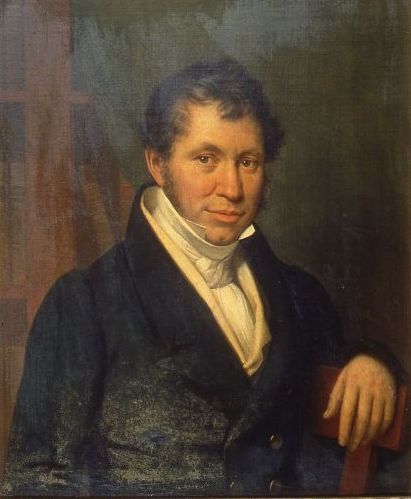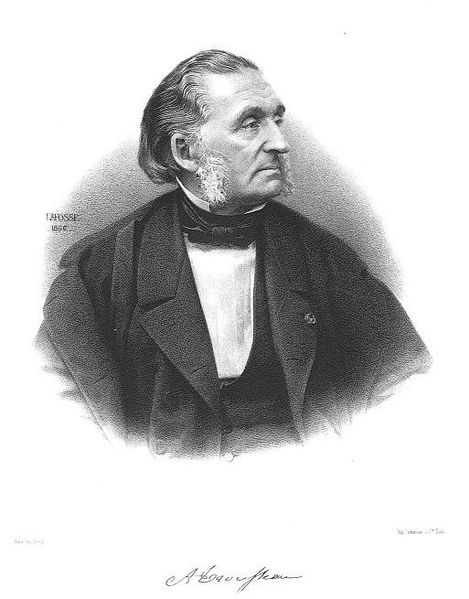<Back to Index>
- Physician Pierre - Fidèle Bretonneau, 1778
- Internist Armand Trousseau, 1801
PAGE SPONSOR

Pierre - Fidèle Bretonneau (3 April 1778 – 1862) was a French medical doctor.
Born at Saint - Georges - sur - Cher, in the Loir - et - Cher département. His father was a surgeon. He studied with his uncle, the vicar at Chenonceaux (Indre - et - Loire) department along with the children of the Chenonceau château. Madame Dupin, the grandmother of George Sand, financed his medical studies in Paris.
He married Madame Dupin's lecturer and settled in Renaudière in Chenonceaux (the Renaudière is currently a restaurant and hotel). Very curious and clever, he had a laboratory at his disposal and occupied himself with gardening and other manual labors in his spare time.
He was the mayor of Chenonceaux from 1803 to 1807. He spent 15 years at Chenonceaux gaining experience, wrote his thesis in medicine in 1815 and then became medical director at the hospital in Tours; which currently bears his name. He continued his study of disease and founded the medical school at Tours.
Bretonneau died in 1862. He is buried in Saint - Cyr - sur - Loire, near Tours.
Bretonneau is one of the pioneers of modern medicine. He identified typhoid fever and named diphtheria. His students included Alfred - Armand - Louis - Marie Velpeau, and Armand Trousseau.
He performed the first successful tracheotomy in 1825, distinguished between scarlet fever and diphtheria in 1826. He studied disease in detail and was the first to think that disease was caused by bacteria in 1855, however, a microscope was not available to him and he was unable to confirm his hypothesis. He also discovered that the same illness could manifest itself differently in different patients. It was the beginning of scientific medicine: where careful observation is used to find cures for sickness and solutions to problems.
- The faculty of medicine in Tours is decorated with three large bronze medallions representing Bretonneau, Velpeau and Trousseau.
- His bust is on display at the city hall in Saint - Georges - sur - Cher.
- The Grévin Museum in Tours has created a reenactment of an anatomy lesson given by Bretonneau, Velpeau and Trousseau.

Armand Trousseau (14 October 1801 – 27 June 1867) was a French internist. His contributions to medicine include Trousseau sign of malignancy, Trousseau sign of latent tetany, Trousseau - Lallemand bodies (an archaic synonym for Bence Jones cylinders), and the truism, "use new drugs quickly, while they still work."
A native of Tours, Indre - et - Loire, Armand Trousseau began his medical studies in his native town as a pupil of Pierre Fidele Bretonneau at the local general hospital. He later continued his studies in Paris, where he received his doctorate in 1825 and became adjunct faculty in 1827. In 1828, the French government assigned him to investigate epidemics ravaging some parts of southern France. After completing his mission the same year, Trousseau traveled to Gibraltar as a member of a commission to investigate yellow fever. This work, and a monograph on laryngeal phthisis, led to his early recognition in Paris.
In 1830 Trousseau became Médecin des hôpitaux through concours, and in 1832 received a position in public health with the central bureau while working as a physician in the Hôtel - Dieu under Joseph Claude Anthelme Récamier. In 1837 he received the great prize of the academy. In 1839 he was appointed physician at the Hôpital St. Antoine and eventually became Chair of therapy and pharmacology at the Paris medical faculty. In 1850 he assumed the Chair of clinical medicine and again commenced working in the Hôtel - Dieu. He was also active in politics, particularly after the French Revolution of 1848, holding several positions including being a member of the legislative body. During his later years Trousseau developed pancreatic cancer. Ironically, he previously described Trousseau sign of malignancy and developed a similar finding in himself. This cancer limited his activities and eventually proved fatal.
Trousseau was instrumental in creating new modes of treatment of croup, emphysema, pleurisy, goiter and malaria. He received the prize of the French Academy of Medicine for his classic essay on laryngology which originally appeared in 1837. He was the first in France to perform a tracheotomy, and he wrote a monograph on this as well as intubation in 1851. His textbooks on clinical medicine and therapeutics were both extremely popular and translated into English. Trousseau coined the terms aphasia and forme fruste and popularized eponyms in disease description such as Addison's disease and Hodgkin's lymphoma.
Trousseau was considered an outstanding teacher. Numerous students of his achieved fame in their own right, including Puerto Rican pro - independence leader, surgeon and Légion d'honneur laureate, Ramón Emeterio Betances.Trousseau’s son Georges Phillipe Trousseau (1833 – 1894) became the royal doctor of the Kingdom of Hawaii, and his grandson was the distinguished ophthalmologist Armand Henri Trousseau (1856 – 1910).